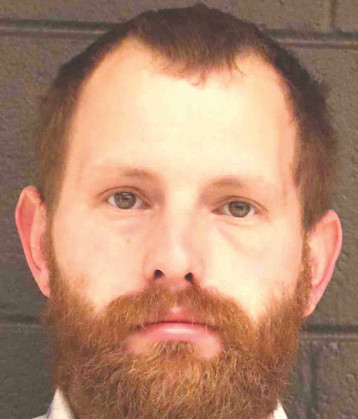Opening statements heard in trial of Robert Thrash

He is charged with burglary, second-degree murder
ALAMOSA — Opening statements were made on Tuesday in the trial of Robert Thrash, who has been charged with first-degree burglary, a class three felony, and second-degree murder, a class two felony, in connection with the Dec. 8, 2022, fatal shooting of Phil Lucero.
Proceedings began Monday with jury selection, which, according to a clerk with the court, did not finish until after 5 p.m.
According to court documents obtained by the Valley Courier, Thrash, 31, was employed as a bondsman for Always Open Bail Bonds at the time of the shooting. He had been told that Lucero, 30, who was a wanted suspect out on bond for failure to appear, was staying at a residence in the 2900 block of West 6th Street.
At about 4:30 p.m. on Dec. 8, 2022, Thrash and his partner, 31-year-old David Heinstein, arrived at the residence. Thrash was armed and carrying a taser; Heinstein was only carrying a firearm.
Thrash entered the house through the front door while Heinstein stood at the back door. Lucero, upon seeing Thrash, attempted to run away but was tased. Heinstein, hearing yelling inside the house, entered the residence with his weapon drawn, according to court documents.
A struggle ensued between Thrash, Lucero and Heinstein, during which Lucero got control of Heinstein’s firearm and shot him in the shoulder. Thrash then fired his weapon, shooting Lucero five times. Lucero later died from his wounds.
The opening statement for the prosecution was made by Deputy District Attorney Joseph Hensley, who is co-counsel assisting District Attorney Anne Kelly in the case.
Hensley described for the jury the events of Dec. 8, 2022, beginning with Thrash, a bondsman who had posted bond for Lucero’s bond. When Lucero failed to appear in court, Thrash “was out a thousand dollars.”
Hensley said Robert Thrash, “not officer Thrash, not deputy Thrash, not trooper Thrash, but Robert Thrash, a bondsman,” approached the residence on West 6th Street “without requesting assistance from law enforcement.” He then entered the residence “without permission,” and then, Hensley said, “chased Lucero,” “tased Lucero” and then, “after Mr. Lucero struggled with David Heinstein for Mr. Heinstein’s gun, Robert Thrash shot Mr. Lucero five times with a nine millimeter pistol,” killing him.
Hensley said the jury would hear from investigators, others who analyze the evidence including doctors and others who were inside the home.
He then told the jury to consider three things when hearing the evidence presented - specifically, the approach, the entry and the chase.
Hensley told the jury Thrash did not call law enforcement for assistance, “even though he knew that was the appropriate action.” When Thrash approached the house, “he was carrying two pistols, a taser and body armor. What was his mindset?” Hensley asked.
Regarding the entry and the subsequent chase, he described Thrash as “barging into the house” without permission and then going after Lucero, “who had only been staying there for a few days.” Thrash then “chased Lucero and tased him”, rather than letting him leave or try to run.
“Where was [Lucero] going to run?” Hensley asked.
He then got into a physical struggle with Lucero, rather than assessing or trying to leave. “The defendant stayed in that home for two whole minutes before shooting Phil Lucero. Not once did he attempt to leave until after shooting Phil Lucero.”
Riley Selleck, the public defender representing Thrash, framed the shooting as a matter of self-defense.
Selleck told the jury they were going to hear about other issues, “about bondsmen and what bondsmen are supposed to do and not do. You’ll hear criticism about Mr. Thrash’s performance as a bondsman.
“That is not what this case is about,” Selleck said. “This case concerns Mr. Thrash’s right to defend himself and, even more importantly, defend the life of his partner, Mr. Heinstein.”
Selleck said it was relatively well known that Lucero was wanted for failing to appear, and, prior to Dec. 8, 2022, Thrash had been contacted by several people with information regarding Lucero’s whereabouts. The individuals with information were interested in the reward money associated with Lucero being found.
One of those people, Selleck said, was a man named Gonzales who, with Thrash, planned to go to the house and say something to get Lucero to come outside, at which time Thrash could take Lucero to jail. However, when Thrash and Heinstein followed Gonzales to the residence, they never saw Lucero come out of the house.
Since Thrash had been contacted by the owner of the house, Selleck said, Thrash knocked on the door.
Selleck said the jury will hear conflicting testimony, including what the homeowner says she did when Thrash entered the home. He said Thrash identified himself as the bondsman, after which the homeowner let him in.
Selleck then listed the other points described by the prosecution that, he said, are “disputed.” He acknowledges that Thrash did have concerns about approaching Lucero, which is why he had his taser ready to use. But, as Selleck described it, Lucero attacked Thrash and went for his taser, which Thrash deployed, not at Lucero’s back but “his front.”
“This wasn’t a chase,” Selleck said.
Selleck said the struggle did occur, but Heinstein, who didn’t have a taser, did have a firearm during which Lucero managed to get ahold of. Lucero “threatened to kill Heinstein” and then shot him in the shoulder.
Selleck said Thrash “warned Mr. Lucero to let go of the gun then pulled out his gun and shot Mr. Lucero five times.”
“This is about Mr. Heinstein’s life, Mr. Thrash’s life and Mr. Thrash defending both of their lives,” Selleck said.
The trial is expected to last through June 18.



